-
 The author conducts a thorough analysis of the legal content regarding the crime of misappropriation of public tenders provided by art. 246 of the new Criminal Code, incrimination ex novo. With reference to the structure of this infringement, the object of criminal protection, the subjects, the objective and subjective aspect, the forms, modalities and sanctions provided by the law are examined in detail. Within the complementary explanations, the connections of the misappropriation of public tenders with other crimes and some procedural aspects are tackled with. Further, the legislative antecedents of this incrimination regulation, the solutions to be followed in case of occurrence of temporary situations and some elements of comparative law are presented. The author does not hesitate to express his opinion as regards the constitutional content of this criminal deed, its systematization and nature and to advance some of his own solutions and ideas related to this aspect. Towards the ending of this analysis several conclusions and proposals de lege ferenda are presented in order to determine an appropriate protection of the values and social relations concerned by this incrimination, an unitary enforcement of the text and implicitly a better performance of the criminal justice within Romania.
The author conducts a thorough analysis of the legal content regarding the crime of misappropriation of public tenders provided by art. 246 of the new Criminal Code, incrimination ex novo. With reference to the structure of this infringement, the object of criminal protection, the subjects, the objective and subjective aspect, the forms, modalities and sanctions provided by the law are examined in detail. Within the complementary explanations, the connections of the misappropriation of public tenders with other crimes and some procedural aspects are tackled with. Further, the legislative antecedents of this incrimination regulation, the solutions to be followed in case of occurrence of temporary situations and some elements of comparative law are presented. The author does not hesitate to express his opinion as regards the constitutional content of this criminal deed, its systematization and nature and to advance some of his own solutions and ideas related to this aspect. Towards the ending of this analysis several conclusions and proposals de lege ferenda are presented in order to determine an appropriate protection of the values and social relations concerned by this incrimination, an unitary enforcement of the text and implicitly a better performance of the criminal justice within Romania. -
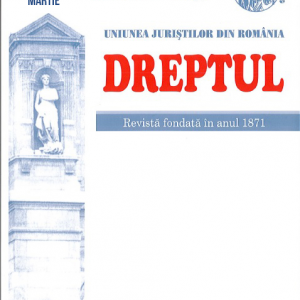 The above study examines specific issues arising from the inheritance regime where the assets of the deceased’s estate include shares, following the death of a limited liability company associate.
The above study examines specific issues arising from the inheritance regime where the assets of the deceased’s estate include shares, following the death of a limited liability company associate. -
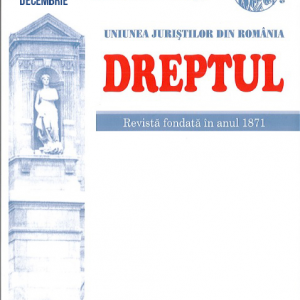 In this study the author makes a comprehensive analysis of cyber crime and how to fight, prevent and investigate this. The analytical approach is based on the definition of cyber crime, of its characteristics, and finally on the identification of the specific means of evidence that are used in the criminal investigations
In this study the author makes a comprehensive analysis of cyber crime and how to fight, prevent and investigate this. The analytical approach is based on the definition of cyber crime, of its characteristics, and finally on the identification of the specific means of evidence that are used in the criminal investigations -
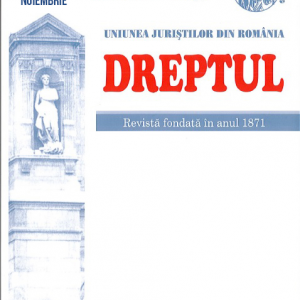 This paper presents propter rem obligations in terms of their distinctive characteristics that prevent their inclusion in the classical categories of property rights and obligations. The incidental nature of these obligations is emphasized in relation to the real right on which the prevalence if the intuitu rei nature is grafted in relation to that of intuitu personae and, as a consequence of these, the propter rem obligation perpetuity. The purpose of the propter rem obligation, is to facilitate the operation of real estate that is subject to real right on which is grafted, helps us decipher the accesoriality relation concerning the real right, the transmission mechanism of these obligations, and the abandon as a sanction occurring in case of failure to comply with these obligations. Recourse to abandon is not only the sanction for the non-performance of these obligations, but also the individual having the propter rem obligation, who releases himself from the performance of the obligation in this way. The last part of the paper helps to explain how certain propter rem obligations set forth in the Civil Code or in certain special laws are created and transmitted, which raises questions on the propter rem nature of some of these.
This paper presents propter rem obligations in terms of their distinctive characteristics that prevent their inclusion in the classical categories of property rights and obligations. The incidental nature of these obligations is emphasized in relation to the real right on which the prevalence if the intuitu rei nature is grafted in relation to that of intuitu personae and, as a consequence of these, the propter rem obligation perpetuity. The purpose of the propter rem obligation, is to facilitate the operation of real estate that is subject to real right on which is grafted, helps us decipher the accesoriality relation concerning the real right, the transmission mechanism of these obligations, and the abandon as a sanction occurring in case of failure to comply with these obligations. Recourse to abandon is not only the sanction for the non-performance of these obligations, but also the individual having the propter rem obligation, who releases himself from the performance of the obligation in this way. The last part of the paper helps to explain how certain propter rem obligations set forth in the Civil Code or in certain special laws are created and transmitted, which raises questions on the propter rem nature of some of these. -
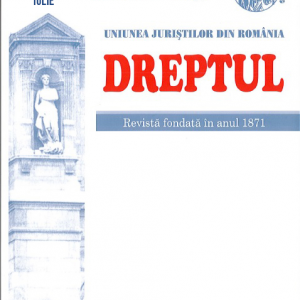 In terms of the decision not to initiate criminal proceedings, ordered by the Prosecutor during the stage of preliminary documents, it is mandatory to communicate the decision to the prejudiced person, indicter and perpetrator, if known, and the deadline of 20 days for filing the complaint with the Prosecutor’s Office runs from the date of serving the decision. For the people who consider themselves injured as to their legitimate interests by the adoption of the decision not to initiate court proceedings, there is neither the obligation, nor the opportunity for the communication thereof and, in this case, the 20-day deadline for filing the complaint against the decision runs from the date on which the person entitled was informed, in any way, about the adoption of the decision in question.
In terms of the decision not to initiate criminal proceedings, ordered by the Prosecutor during the stage of preliminary documents, it is mandatory to communicate the decision to the prejudiced person, indicter and perpetrator, if known, and the deadline of 20 days for filing the complaint with the Prosecutor’s Office runs from the date of serving the decision. For the people who consider themselves injured as to their legitimate interests by the adoption of the decision not to initiate court proceedings, there is neither the obligation, nor the opportunity for the communication thereof and, in this case, the 20-day deadline for filing the complaint against the decision runs from the date on which the person entitled was informed, in any way, about the adoption of the decision in question. -
 The choice made by the Romanian pouvoir constituant in 1991 in favour of the European model of constitutional review does not seem to have been followed by legal terminology. Most probably in order not to break with a tradition that still enjoys good reputation among legal scholars and practitioners, the label of „exception of unconstitutionality” has been preferred to the one of „preliminary reference”. This apparently minor semantic detail managed to have a lasting impact on the admissibility of this procedure to the point where the very legal institution has been completely transfigured: from a preliminary question it has become a defensive procedural tool.
The choice made by the Romanian pouvoir constituant in 1991 in favour of the European model of constitutional review does not seem to have been followed by legal terminology. Most probably in order not to break with a tradition that still enjoys good reputation among legal scholars and practitioners, the label of „exception of unconstitutionality” has been preferred to the one of „preliminary reference”. This apparently minor semantic detail managed to have a lasting impact on the admissibility of this procedure to the point where the very legal institution has been completely transfigured: from a preliminary question it has become a defensive procedural tool. -
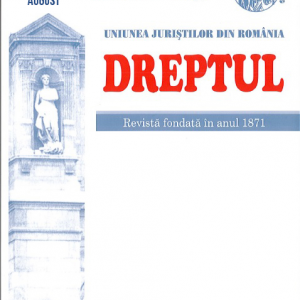 This study sets some reference points for a new institution regulated by the Criminal Procedure Code – the judge of rights and freedoms – from a perspective which stresses its role in protecting the rights and fundamental freedoms, as they are established by the Constitution and by the international treaties on human rights to which Romania is a party.
This study sets some reference points for a new institution regulated by the Criminal Procedure Code – the judge of rights and freedoms – from a perspective which stresses its role in protecting the rights and fundamental freedoms, as they are established by the Constitution and by the international treaties on human rights to which Romania is a party. -
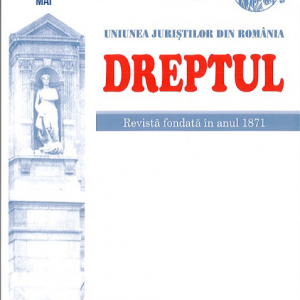 This study analyzes the new structure of the judgment based on the guilty plea, describes the conditions of application of this simplified procedure in comparison with the previous regulation, the rules of conduct of the special judicial investigation, the solutions which can be issued by courts in order to solve the criminal action, all these by emphasizing the advantages or shortcomings of the new institution.
This study analyzes the new structure of the judgment based on the guilty plea, describes the conditions of application of this simplified procedure in comparison with the previous regulation, the rules of conduct of the special judicial investigation, the solutions which can be issued by courts in order to solve the criminal action, all these by emphasizing the advantages or shortcomings of the new institution. -
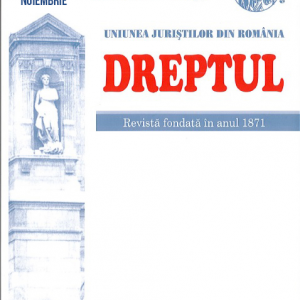 This study focuses on the difficulties identified in the practice of the law courts which establishes the processual remedy made available by the criminal processual law assuming that two or more criminal judgments, on the same subject, were pronounced at different times. Thus, the judicial practice has outlined different visions in the qualification of the legal remedy given the proximity that may be encountered between the case of review on the irreconcilability of the judgments and the case of appeal for annulment on the infringement of the authority of res iudicata.
This study focuses on the difficulties identified in the practice of the law courts which establishes the processual remedy made available by the criminal processual law assuming that two or more criminal judgments, on the same subject, were pronounced at different times. Thus, the judicial practice has outlined different visions in the qualification of the legal remedy given the proximity that may be encountered between the case of review on the irreconcilability of the judgments and the case of appeal for annulment on the infringement of the authority of res iudicata. -
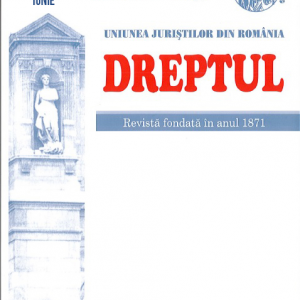 Within every form of legal liability, the act inconsistent with the legal rules for which liability is engaged is qualified expressly by law. This study aims to analyze comparatively the offence and the contravention, regarded in the light of recent legislative influences, appeared in the field of criminal law. In order to achieve this intended objective, the structure of the material elaborated by the author envisages the following sequence: the historical evolution of the offence and of the contravention; the definition of the offence and of the contravention; the system of punishments and the sanctioning regime; other aspects of the legal regime of the offence and of the contravention. The analysis covers the following: the stage of legislation, the point of view of the doctrine, as well as the case-law. Finally, there are presented the conclusions reached as a result of this approach and there are formulated de lege ferenda proposals.
Within every form of legal liability, the act inconsistent with the legal rules for which liability is engaged is qualified expressly by law. This study aims to analyze comparatively the offence and the contravention, regarded in the light of recent legislative influences, appeared in the field of criminal law. In order to achieve this intended objective, the structure of the material elaborated by the author envisages the following sequence: the historical evolution of the offence and of the contravention; the definition of the offence and of the contravention; the system of punishments and the sanctioning regime; other aspects of the legal regime of the offence and of the contravention. The analysis covers the following: the stage of legislation, the point of view of the doctrine, as well as the case-law. Finally, there are presented the conclusions reached as a result of this approach and there are formulated de lege ferenda proposals. -
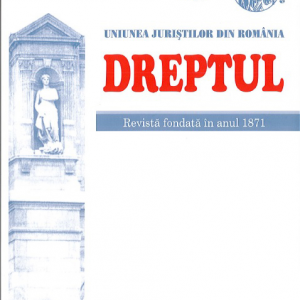 Contractul de asistență juridică învestit cu formulă executorie, în condițiile legii, constituie titlu executoriu cu privire la restanțele din onorariu și alte cheltuieli efectuate de avocat în interesul clientului. Este nelegală executarea silită pornită pentru o sumă pe care creditoarea o apreciază ca fiind datorată cu titlu de prejudiciu pentru încălcarea obligațiilor contractuale. Creanța nu reprezintă o plată pentru o activitate profesională desfășurată de societatea de avocatură, ci o despăgubire pentru încălcarea clauzelor contractuale de către contestator, având astfel caracterul unei clauze penale. Din această perspectivă nu prezintă relevanță în ce măsură creditoarea putea desfășura activități de intermediere sportivă ori dacă putea pretinde debitorului executarea obligației garantate potrivit contractului de ipotecă mobiliară pentru o nerespectare a obligațiilor asumate în cazul unui transfer. Nu este permis ca prin convenția lor părțile să poată ca, sub denumirea de „onorariu”, să-și creeze un titlu executoriu pentru o creanță care în realitate este o despăgubire.
Contractul de asistență juridică învestit cu formulă executorie, în condițiile legii, constituie titlu executoriu cu privire la restanțele din onorariu și alte cheltuieli efectuate de avocat în interesul clientului. Este nelegală executarea silită pornită pentru o sumă pe care creditoarea o apreciază ca fiind datorată cu titlu de prejudiciu pentru încălcarea obligațiilor contractuale. Creanța nu reprezintă o plată pentru o activitate profesională desfășurată de societatea de avocatură, ci o despăgubire pentru încălcarea clauzelor contractuale de către contestator, având astfel caracterul unei clauze penale. Din această perspectivă nu prezintă relevanță în ce măsură creditoarea putea desfășura activități de intermediere sportivă ori dacă putea pretinde debitorului executarea obligației garantate potrivit contractului de ipotecă mobiliară pentru o nerespectare a obligațiilor asumate în cazul unui transfer. Nu este permis ca prin convenția lor părțile să poată ca, sub denumirea de „onorariu”, să-și creeze un titlu executoriu pentru o creanță care în realitate este o despăgubire. -
 The article presents the results of a research conducted in six European countries mainly on the analysis of the exceptional nature of preventive arrest within these jurisdictions. In this article there are presented the main results of the research conducted in Romania, research that was based on a series of interviews with judges, prosecutors and lawyers. The main areas investigated have concerned aspects such as the analysis of the decision-making process, the situation of the foreign citizens subject to preventive measures, the manner of application of alternative measures to preventive arrest, the analysis of the current criminal processual normative framework, as well as of the impact in the current practice of the European regulations, etc. The conclusions of the study are in the sense that in Romania there have been registered also some aspects representing progress in the sense of protection of the fundamental human rights in the cases where it is raised the question of taking some preventive measures in the criminal cases – such as the fact that the tendency, at least in terms of using the preventive arrest, is a decreasing one. However, major deficiencies have also been found, related to the organization of the initial and continuing training for magistrates, in the sense that they have been found to be unaware of judicial instruments important for their activity. It is precisely about instruments that are capable of improving the situation of foreign persons in relation to the state where it is raised the judicial matter – respectively the European Surveillance Order.
The article presents the results of a research conducted in six European countries mainly on the analysis of the exceptional nature of preventive arrest within these jurisdictions. In this article there are presented the main results of the research conducted in Romania, research that was based on a series of interviews with judges, prosecutors and lawyers. The main areas investigated have concerned aspects such as the analysis of the decision-making process, the situation of the foreign citizens subject to preventive measures, the manner of application of alternative measures to preventive arrest, the analysis of the current criminal processual normative framework, as well as of the impact in the current practice of the European regulations, etc. The conclusions of the study are in the sense that in Romania there have been registered also some aspects representing progress in the sense of protection of the fundamental human rights in the cases where it is raised the question of taking some preventive measures in the criminal cases – such as the fact that the tendency, at least in terms of using the preventive arrest, is a decreasing one. However, major deficiencies have also been found, related to the organization of the initial and continuing training for magistrates, in the sense that they have been found to be unaware of judicial instruments important for their activity. It is precisely about instruments that are capable of improving the situation of foreign persons in relation to the state where it is raised the judicial matter – respectively the European Surveillance Order. -
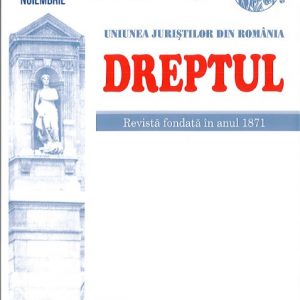 Within this study, the authors intend to analyse the enforcement of judgments pronounced by the administrative disputes courts, in the light of the general provisions of the Civil Procedure Code and of the special provisions of the Law on administrative disputes No 554/2004, as well as of the case law in this matter.
Within this study, the authors intend to analyse the enforcement of judgments pronounced by the administrative disputes courts, in the light of the general provisions of the Civil Procedure Code and of the special provisions of the Law on administrative disputes No 554/2004, as well as of the case law in this matter. -
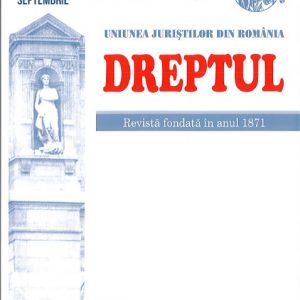 This study includes an analysis of the provisions of the new Criminal Procedure Code referring to the warrant for technical supervision when it concerns the financial transactions of a person in relation to the provisions of Article 153 on obtaining data concerning the financial situation, the utility and appropriateness of using the two institutions, as well as the comparative analysis in relation to the old regulations. The author also presents critical aspects with regard to these institutions, having in view the different interpretations given in the judicial practice, as well as de lege ferenda proposals. The study refers only to the data concerning the financial transactions of a natural or legal person related to a bank account and the subsequent operations.
This study includes an analysis of the provisions of the new Criminal Procedure Code referring to the warrant for technical supervision when it concerns the financial transactions of a person in relation to the provisions of Article 153 on obtaining data concerning the financial situation, the utility and appropriateness of using the two institutions, as well as the comparative analysis in relation to the old regulations. The author also presents critical aspects with regard to these institutions, having in view the different interpretations given in the judicial practice, as well as de lege ferenda proposals. The study refers only to the data concerning the financial transactions of a natural or legal person related to a bank account and the subsequent operations. -
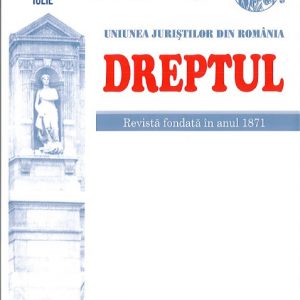 This study aims to identify the arguments for which, in the current legislative context, it is not admissible to order the sending of the case for retrial by the judgment pronounced on the application for annulment. The application for annulment, as a legal remedy, is regulated within the procedure of payment order.
This study aims to identify the arguments for which, in the current legislative context, it is not admissible to order the sending of the case for retrial by the judgment pronounced on the application for annulment. The application for annulment, as a legal remedy, is regulated within the procedure of payment order. -
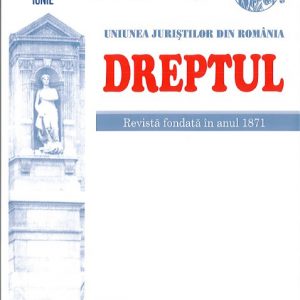 In this paper the author makes an analysis of the provisions relating to „Aggravated theft” (Article 229 of the Criminal Code), from the perspective of the comparative law and of the requirements of the principle of legality. There are emphasized a series of errors produced during the drafting of the text (setting an excessively large number of circumstantial elements, their arbitrary grouping, etc.) and, at the same time, there are presented some solutions to overcome the deficiencies.
In this paper the author makes an analysis of the provisions relating to „Aggravated theft” (Article 229 of the Criminal Code), from the perspective of the comparative law and of the requirements of the principle of legality. There are emphasized a series of errors produced during the drafting of the text (setting an excessively large number of circumstantial elements, their arbitrary grouping, etc.) and, at the same time, there are presented some solutions to overcome the deficiencies. -
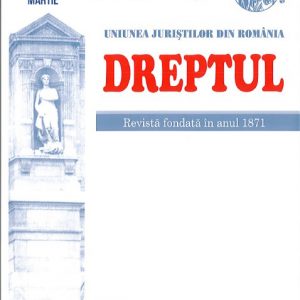 According to Article 172 (12) of the Criminal Procedure Code „After the finalisation of the fact-finding report, whenever the judicial body considers necessary the opinion of an expert or whenever the conclusions of the fact-finding report are contested, an expertise shall be ordered to be made.” This legal text is not correlated with the rest of the provisions of the Criminal Procedure Code in force, nor with the other provisions of the previous codes, therefore, in the author’s opinion, this fact is likely to give rise to controversies. In a different line of ideas, the author argues that the legislator imposes as processual remedy that upon the finalization of the fact-finding report, in case its conclusions are only contested, to order an expertise to be conducted. This hypothesis is even more questionable as there is the possibility that the judicial body appreciates that the opinion of such an expert is not necessary. Thus, the legislator acts instead of the place of the judicial body in deciding on the admissibility of such means of evidence. Starting from such an inadvertence, in a given case, although the judicial body has concluded on the lack of utility and conclusiveness of an expertise, taking into account that one of the subjects to the trial, a defendant in this case, has contested the conclusions of some previous technical-scientific reports and even of an initial expertise report, both the prosecutor, during the phase of criminal prosecution, and the judge, during the phase of trial, had to admit, according to the text of the law, the contestation or the application of that subject to the trial respectively and thus to order an expertise to be conducted. The author believes that the mentioned text provision is also contrary to the contents of several normative acts that provide the independence of the judge and of the prosecutor in the activity of criminal investigation and in the phase of trial, as well as their exclusive competence to decide on the processual acts and measures, as the case is undergoing the phase of criminal prosecution, of preliminary chamber or of trial. Moreover, in support of the opinions which the author has expressed in this article, he also brings arguments of comparative law, showing that the analysis made has not identified legislations or points of view from other countries, convergent with the text of Article 172 (12) of the Criminal Procedure Code. In conclusion, for the reasons shown within this article, the author appreciates that it is required a reconsideration and reformulation of the text of Article 172 (12) of the Criminal Procedure Code from the legislator.
According to Article 172 (12) of the Criminal Procedure Code „After the finalisation of the fact-finding report, whenever the judicial body considers necessary the opinion of an expert or whenever the conclusions of the fact-finding report are contested, an expertise shall be ordered to be made.” This legal text is not correlated with the rest of the provisions of the Criminal Procedure Code in force, nor with the other provisions of the previous codes, therefore, in the author’s opinion, this fact is likely to give rise to controversies. In a different line of ideas, the author argues that the legislator imposes as processual remedy that upon the finalization of the fact-finding report, in case its conclusions are only contested, to order an expertise to be conducted. This hypothesis is even more questionable as there is the possibility that the judicial body appreciates that the opinion of such an expert is not necessary. Thus, the legislator acts instead of the place of the judicial body in deciding on the admissibility of such means of evidence. Starting from such an inadvertence, in a given case, although the judicial body has concluded on the lack of utility and conclusiveness of an expertise, taking into account that one of the subjects to the trial, a defendant in this case, has contested the conclusions of some previous technical-scientific reports and even of an initial expertise report, both the prosecutor, during the phase of criminal prosecution, and the judge, during the phase of trial, had to admit, according to the text of the law, the contestation or the application of that subject to the trial respectively and thus to order an expertise to be conducted. The author believes that the mentioned text provision is also contrary to the contents of several normative acts that provide the independence of the judge and of the prosecutor in the activity of criminal investigation and in the phase of trial, as well as their exclusive competence to decide on the processual acts and measures, as the case is undergoing the phase of criminal prosecution, of preliminary chamber or of trial. Moreover, in support of the opinions which the author has expressed in this article, he also brings arguments of comparative law, showing that the analysis made has not identified legislations or points of view from other countries, convergent with the text of Article 172 (12) of the Criminal Procedure Code. In conclusion, for the reasons shown within this article, the author appreciates that it is required a reconsideration and reformulation of the text of Article 172 (12) of the Criminal Procedure Code from the legislator. -
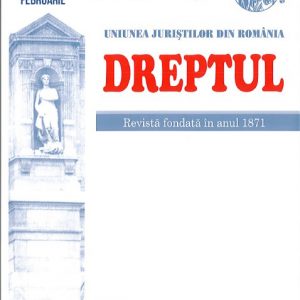 Dispozițiile art. 44 alin. (3) C.pr.pen. reglementează un caz de prorogare legală a competenței, în sensul că infracțiunea de favorizare a făptuitorului este de competența instanței care judecă infracțiunea la care aceasta se referă, competența materială a infracțiunii corelative fiind câștigată mai înainte și independent de reunirea cauzelor. În acest context, dacă judecătorul de cameră preliminară care funcționează la judecătorie, fiind sesizat prin rechizitoriu cu judecarea unei infracțiuni de favorizare a făptuitorului – făptuitorul favorizat fiind judecat de către tribunal – verifică și menține măsura preventivă luată în faza urmăririi penale, violează dispozițiile relative la competența materială a instanțelor de judecată prevăzute sub sancțiunea nulității absolute, potrivit art. 281 alin. (1) lit. b) C.pr.pen. (cu notă critică).
Dispozițiile art. 44 alin. (3) C.pr.pen. reglementează un caz de prorogare legală a competenței, în sensul că infracțiunea de favorizare a făptuitorului este de competența instanței care judecă infracțiunea la care aceasta se referă, competența materială a infracțiunii corelative fiind câștigată mai înainte și independent de reunirea cauzelor. În acest context, dacă judecătorul de cameră preliminară care funcționează la judecătorie, fiind sesizat prin rechizitoriu cu judecarea unei infracțiuni de favorizare a făptuitorului – făptuitorul favorizat fiind judecat de către tribunal – verifică și menține măsura preventivă luată în faza urmăririi penale, violează dispozițiile relative la competența materială a instanțelor de judecată prevăzute sub sancțiunea nulității absolute, potrivit art. 281 alin. (1) lit. b) C.pr.pen. (cu notă critică). -
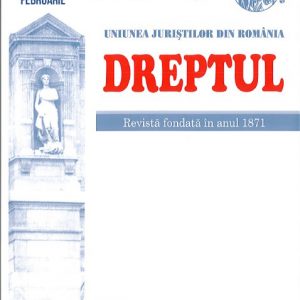 Aspecte introductive. Dispozițiile legale vizate direct de conținutul Deciziei Curții Constituționale nr. 405/20161 sunt art. 246 din Codul penal anterior și art. 297 din Codul penal în vigoare. Conform art. 246 din Codul penal din 1969: „Fapta funcționarului public, care, în exercițiul atribuțiilor sale de serviciu, cu știință, nu îndeplinește un act ori îl îndeplinește în mod defectuos și prin aceasta cauzează o vătămare intereselor legale ale unei persoane se pedepsește cu închisoare de la 6 luni la 3 ani.”
Aspecte introductive. Dispozițiile legale vizate direct de conținutul Deciziei Curții Constituționale nr. 405/20161 sunt art. 246 din Codul penal anterior și art. 297 din Codul penal în vigoare. Conform art. 246 din Codul penal din 1969: „Fapta funcționarului public, care, în exercițiul atribuțiilor sale de serviciu, cu știință, nu îndeplinește un act ori îl îndeplinește în mod defectuos și prin aceasta cauzează o vătămare intereselor legale ale unei persoane se pedepsește cu închisoare de la 6 luni la 3 ani.” -
 In principle, except for the emergency situations, it is requested the consent from the parents in order to apply a medical treatment to the minor patient, being essential the minor’s interest and the protection of the minor, of his life and health. In the study there are analysed the legal consequences of having a medical malpractice case for the deed of a physician who, in some situations, applies to a minor patient who is part of the Religious Organization „Jehovah’s Witnesses”, a religious cult recognized by the law in Romania, a treatment based on the blood transfusion, provided that there is a refusal of the parents, who are Jehovah’s Witnesses, on religious grounds1. Jehovah’s Witnesses refuse the treatment based on transfusions of allogenic blood. It must be pointed out the difference between the major person, who is part of the Religious Organization „Jehovah’s Witnesses”, who refuses blood transfusion treatment, requesting treatments alternative to blood transfusion, based on the principle of self-determination and individual autonomy, and the situation involving a refusal of the treatment from the parent for the minor patient (who can not give an informed consent, either because he has no discernment, being under 14 years old, or because he is in the growing up process, 14–18 years old), who is sometimes in a medical condition with risks to his or her health or life, and the physician appeciates that medical treatment based on blood transfusion must be administered, even against the refusal of the minor’s parents, with risks of engaging his liability for medical malpractice.
In principle, except for the emergency situations, it is requested the consent from the parents in order to apply a medical treatment to the minor patient, being essential the minor’s interest and the protection of the minor, of his life and health. In the study there are analysed the legal consequences of having a medical malpractice case for the deed of a physician who, in some situations, applies to a minor patient who is part of the Religious Organization „Jehovah’s Witnesses”, a religious cult recognized by the law in Romania, a treatment based on the blood transfusion, provided that there is a refusal of the parents, who are Jehovah’s Witnesses, on religious grounds1. Jehovah’s Witnesses refuse the treatment based on transfusions of allogenic blood. It must be pointed out the difference between the major person, who is part of the Religious Organization „Jehovah’s Witnesses”, who refuses blood transfusion treatment, requesting treatments alternative to blood transfusion, based on the principle of self-determination and individual autonomy, and the situation involving a refusal of the treatment from the parent for the minor patient (who can not give an informed consent, either because he has no discernment, being under 14 years old, or because he is in the growing up process, 14–18 years old), who is sometimes in a medical condition with risks to his or her health or life, and the physician appeciates that medical treatment based on blood transfusion must be administered, even against the refusal of the minor’s parents, with risks of engaging his liability for medical malpractice. -
 This study emphasizes that, from a substantial point of view, the criteria required to be fulfilled for cataloguing a deed as pertaining to the criminal domain are: the qualification of the deed in the domestic law, the nature of the deed and the purpose and the severity of the sanction. Formally, an official report of finding and sanctioning the contravention which represents at the same time also a criminal charge in the conventional sense must cumulatively include the description of the deed and the presentation of the legal classification. The effect of classifying the report of finding and sanctioning the contravention in the category of the criminal charge in a conventional sense is given by the fact that to the procedure for finding and sanctioning the contravention there are attached its own guarantees of a fair trial. The presumption of lawfulness of the report is compatible with the presumption of innocence only if it respects certain limits, taking into account the gravity of the stake and protecting the rights of the defence. The limits of the presumption of lawfulness of the official report, in the context of protecting the rights of the defence, are: the imperative that the deed be perceived directly, through its own senses, by the fact-finding agent and the exigence not to impose on the person concerned an impossible task, as regards the administration of the proof to the contrary.
This study emphasizes that, from a substantial point of view, the criteria required to be fulfilled for cataloguing a deed as pertaining to the criminal domain are: the qualification of the deed in the domestic law, the nature of the deed and the purpose and the severity of the sanction. Formally, an official report of finding and sanctioning the contravention which represents at the same time also a criminal charge in the conventional sense must cumulatively include the description of the deed and the presentation of the legal classification. The effect of classifying the report of finding and sanctioning the contravention in the category of the criminal charge in a conventional sense is given by the fact that to the procedure for finding and sanctioning the contravention there are attached its own guarantees of a fair trial. The presumption of lawfulness of the report is compatible with the presumption of innocence only if it respects certain limits, taking into account the gravity of the stake and protecting the rights of the defence. The limits of the presumption of lawfulness of the official report, in the context of protecting the rights of the defence, are: the imperative that the deed be perceived directly, through its own senses, by the fact-finding agent and the exigence not to impose on the person concerned an impossible task, as regards the administration of the proof to the contrary. -
 This study presents the divergent case law generated by the current insufficient regulation of the legal regime of burial plots and funeral constructions, such as burial vaults and crypts. While some courts admit the assignment of the tomb to one heir, others consider that the concession right over the burial plot and the funeral constructions bears upon a forced and perpetual indivisibility which excludes the division. As a solution, it proposes a clarification of the legal regime applicable to funeral concessions and the explicit regulation of the use of underground burial vaults, especially from the perspective of the exclusive right to be buried in a particular crypt.
This study presents the divergent case law generated by the current insufficient regulation of the legal regime of burial plots and funeral constructions, such as burial vaults and crypts. While some courts admit the assignment of the tomb to one heir, others consider that the concession right over the burial plot and the funeral constructions bears upon a forced and perpetual indivisibility which excludes the division. As a solution, it proposes a clarification of the legal regime applicable to funeral concessions and the explicit regulation of the use of underground burial vaults, especially from the perspective of the exclusive right to be buried in a particular crypt. -
 The stages of the civil trial are: (i) the stage of referral to the court of law (written or initiating the civil trial), (ii) the stage of inquiry of the trial, (iii) the stage of debate on the merits of the trial, (iv) the stage of deliberation and (v) the stage of delivery. The accomplishment of the act of justice in civil matters is materialized through court sittings (which may be public, or in which only the parties participate, or not public, in the cases provided by law) and internal administrative stages carried out by the panel of judges (such as the checking and regularisation of the application). Publicity is a fundamental principle of the civil trial stated by the provisions of Article 17 of the Civil Procedure Code and by Article 12 of the Law No 304/2004, republished. The failure to ensure the publicity of the court sitting brings about the sanction of absolute nullity not conditioned by the existence of an injury under Article 174 (2) by reference to Article 176 point 5 of the Civil Procedure Code. The delivery of the judgment shall usually take place in public sitting, according to Article 402 of the Civil Procedure Code, or, as an exception, by making the solution available to the parties through the mediation of the registry office, pursuant to Article 396 (2) of the same Code, in the assumption that the delivery was postponed (premise condition) for justified reasons and the chairman of the panel has indicated expressis verbis this modality of putting the solution at the disposal of the parties. The delivery of the judgment, as the last processual stage, according to the Civil Procedure Code, can not take place otherwise than by means of a public court sitting, according to the principle of publicity, to which the chairman or a member of the panel of judges read the minutes, also indicating the means of appeal which can be exercised. The fact that the parties understand or not to make use of their right to appear in court (as in the case of other processual stages) does not in any way affect the obligation of the panel of judges to comply with the express provisions of the law in respect of the processual stage of delivery, since there is no such distinction in the law, and ubi lex non distinguit nec non distinguere debemus. In addition, the completion of this final stage of the civil trial is necessary for the parties to make use of their right to formulate orally the means of appeal provided by law, according to Article 126 of the Internal rules of the courts of law of 2015, concluding in this respect a minutes signed by the president of the panel and by the registrar of the sitting.
The stages of the civil trial are: (i) the stage of referral to the court of law (written or initiating the civil trial), (ii) the stage of inquiry of the trial, (iii) the stage of debate on the merits of the trial, (iv) the stage of deliberation and (v) the stage of delivery. The accomplishment of the act of justice in civil matters is materialized through court sittings (which may be public, or in which only the parties participate, or not public, in the cases provided by law) and internal administrative stages carried out by the panel of judges (such as the checking and regularisation of the application). Publicity is a fundamental principle of the civil trial stated by the provisions of Article 17 of the Civil Procedure Code and by Article 12 of the Law No 304/2004, republished. The failure to ensure the publicity of the court sitting brings about the sanction of absolute nullity not conditioned by the existence of an injury under Article 174 (2) by reference to Article 176 point 5 of the Civil Procedure Code. The delivery of the judgment shall usually take place in public sitting, according to Article 402 of the Civil Procedure Code, or, as an exception, by making the solution available to the parties through the mediation of the registry office, pursuant to Article 396 (2) of the same Code, in the assumption that the delivery was postponed (premise condition) for justified reasons and the chairman of the panel has indicated expressis verbis this modality of putting the solution at the disposal of the parties. The delivery of the judgment, as the last processual stage, according to the Civil Procedure Code, can not take place otherwise than by means of a public court sitting, according to the principle of publicity, to which the chairman or a member of the panel of judges read the minutes, also indicating the means of appeal which can be exercised. The fact that the parties understand or not to make use of their right to appear in court (as in the case of other processual stages) does not in any way affect the obligation of the panel of judges to comply with the express provisions of the law in respect of the processual stage of delivery, since there is no such distinction in the law, and ubi lex non distinguit nec non distinguere debemus. In addition, the completion of this final stage of the civil trial is necessary for the parties to make use of their right to formulate orally the means of appeal provided by law, according to Article 126 of the Internal rules of the courts of law of 2015, concluding in this respect a minutes signed by the president of the panel and by the registrar of the sitting. -
 The provisions of Article 169 of the Law No 85/2014 on the procedures for preventing insolvency and for insolvency regulate the responsibility aimed at covering the debtor’s liabilities in case its assets do not satisfy all the claims of its debtors. The mentioned legal provisions regulate expressly determined cases in which either the members of the supervisory bodies, or the members of the management bodies of the legal person which is in a state of insolvency or any other person that has caused the state of insolvency may be obliged to cover a part of the liabilities of the insolvent debtor, provided that the activity they carried out has led to the insufficiency of the available cash funds from the patrimony of the debtor legal person. In relation to the provisions of Article 171 of the mentioned normative act, the responsibility of the specified persons may be engaged in any form of the procedure, either in judicial reorganization, or in bankruptcy. In case of judicial reorganization, the amounts of money obtained as a result of the responsibility of the mentioned persons are intended to supplement the funds necessary for the continuation of the debtor’s activity, and, in case of bankruptcy, those amounts must ensure that the debtor’s liabilities are covered. The regulation of the responsibility of the members of the supervisory/management bodies or of any other person that has caused the state of insolvency of the debtor legal person is an integral part of the procedure provided by the law on insolvency.
The provisions of Article 169 of the Law No 85/2014 on the procedures for preventing insolvency and for insolvency regulate the responsibility aimed at covering the debtor’s liabilities in case its assets do not satisfy all the claims of its debtors. The mentioned legal provisions regulate expressly determined cases in which either the members of the supervisory bodies, or the members of the management bodies of the legal person which is in a state of insolvency or any other person that has caused the state of insolvency may be obliged to cover a part of the liabilities of the insolvent debtor, provided that the activity they carried out has led to the insufficiency of the available cash funds from the patrimony of the debtor legal person. In relation to the provisions of Article 171 of the mentioned normative act, the responsibility of the specified persons may be engaged in any form of the procedure, either in judicial reorganization, or in bankruptcy. In case of judicial reorganization, the amounts of money obtained as a result of the responsibility of the mentioned persons are intended to supplement the funds necessary for the continuation of the debtor’s activity, and, in case of bankruptcy, those amounts must ensure that the debtor’s liabilities are covered. The regulation of the responsibility of the members of the supervisory/management bodies or of any other person that has caused the state of insolvency of the debtor legal person is an integral part of the procedure provided by the law on insolvency. -
 Cloud Computing is one of the most innovative technologies in the history of computing. It is radically changing the way how information technology services are created, delivered, accessed and managed. Cloud Computing enables the same services and user content to be delivered to any user device, whether a mobile phone, desktop or tablet computer. Cloud technology involves data storage at multiple data centers in different geographic locations. The evolution of computer technology is strongly related with the cybercrime phenomenon. Over the last decade, the number of crimes that involve computers and Internet has grown constantly. Criminal organizations try to be as efficient as possible and in order to make investigations difficult they are storing criminal data in foreign servers or in Cloud storage systems, and use cryptography and other data obfuscation techniques that hide their illicit activity. Cloud Computing offers criminals accessible means for committing cybercrime. In much the same way as cybercrime may be understood as a new way of committing traditional crimes such as fraud and theft, Cloud Computing presents criminals with new tools with which to commit these offences and many more. Researching this environment is a key element in understanding the new and more complex forms of cybercrime that occur today.
Cloud Computing is one of the most innovative technologies in the history of computing. It is radically changing the way how information technology services are created, delivered, accessed and managed. Cloud Computing enables the same services and user content to be delivered to any user device, whether a mobile phone, desktop or tablet computer. Cloud technology involves data storage at multiple data centers in different geographic locations. The evolution of computer technology is strongly related with the cybercrime phenomenon. Over the last decade, the number of crimes that involve computers and Internet has grown constantly. Criminal organizations try to be as efficient as possible and in order to make investigations difficult they are storing criminal data in foreign servers or in Cloud storage systems, and use cryptography and other data obfuscation techniques that hide their illicit activity. Cloud Computing offers criminals accessible means for committing cybercrime. In much the same way as cybercrime may be understood as a new way of committing traditional crimes such as fraud and theft, Cloud Computing presents criminals with new tools with which to commit these offences and many more. Researching this environment is a key element in understanding the new and more complex forms of cybercrime that occur today. -
 Unpaid community work has received multiple valences in the Romanian criminal law system, representing either an obligation in the content of the probation measures or a way of executing the penalty of the fine or an obligation that accompanies the abandonment of the criminal prosecution. The complexity of the institution, together with its novelty, has generated a series of difficulties including in respect of the performance of the unpaid community work, this article emphasizing some of these difficulties and proposing solutions for their removal.
Unpaid community work has received multiple valences in the Romanian criminal law system, representing either an obligation in the content of the probation measures or a way of executing the penalty of the fine or an obligation that accompanies the abandonment of the criminal prosecution. The complexity of the institution, together with its novelty, has generated a series of difficulties including in respect of the performance of the unpaid community work, this article emphasizing some of these difficulties and proposing solutions for their removal. -
 The relation between the civil servant and the public authority or institution in which he occupies the public office arises and is exercised on the basis of the unilateral administrative act of appointment, issued according to the legal provisions, and not by a contractual act. That is why the public function and the status of the civil servant have been regulated in the public law, separately from the labour relations specific to the private law, at the same time also determining the establishment of a specific sanctioning system, which takes into account the distinctive features of the way in which the public office is exercised. In this study there are analysed, from a dual perspective, theoretical and practical, the conditions of each form of the legal liability governed by the administrative law. At the same time, we also consider the cumulation of the disciplinary liability with other forms of legal liability of the civil servant for the damaging consequences of his deeds. A few aspects of novelty brought by the codification of the legislation on the liability of the civil servants in the Draft Administrative Code complete our research.
The relation between the civil servant and the public authority or institution in which he occupies the public office arises and is exercised on the basis of the unilateral administrative act of appointment, issued according to the legal provisions, and not by a contractual act. That is why the public function and the status of the civil servant have been regulated in the public law, separately from the labour relations specific to the private law, at the same time also determining the establishment of a specific sanctioning system, which takes into account the distinctive features of the way in which the public office is exercised. In this study there are analysed, from a dual perspective, theoretical and practical, the conditions of each form of the legal liability governed by the administrative law. At the same time, we also consider the cumulation of the disciplinary liability with other forms of legal liability of the civil servant for the damaging consequences of his deeds. A few aspects of novelty brought by the codification of the legislation on the liability of the civil servants in the Draft Administrative Code complete our research. -
 The content of the medical legal relation includes all rights and obligations of the provider and of the beneficiary of the medical service. Among these, only the rights of the patient benefit by an explicit and ample special regulation and by a growing doctrinal interest. However, this does not mean the lack of specific rights in favour of the doctor, but only the necessity to identify the existence and the determination of their content by analyzing the nature and/or the implicit effects of the legal provisions and of the jurisprudential solutions. Thus, the patient’s acceptance by the doctor, based on Article 663 (1) of the Law No 95/2006, is the equivalent of the informed consent of the patient, expressed pursuant to Articles 660–662 of the Law No 95/2006 and Articles 13–20 of the Law No 46/2003; the interruption of the relation between the doctor and the patient, pursuant to Article 664 (1) c) (ii) of the Law No 95/2006, as a result of a hostile and/or irreverent attitude towards the doctor, would be impossible in the absence of an obligation of gratitude of the patient, correlative to a right to gratitude of the doctor; and the jurisprudential consecration of the liability of the sanitary unit for the damage suffered by the doctor due to a nosocomial infection is due precisely to the existence of a right to security of the doctor.
The content of the medical legal relation includes all rights and obligations of the provider and of the beneficiary of the medical service. Among these, only the rights of the patient benefit by an explicit and ample special regulation and by a growing doctrinal interest. However, this does not mean the lack of specific rights in favour of the doctor, but only the necessity to identify the existence and the determination of their content by analyzing the nature and/or the implicit effects of the legal provisions and of the jurisprudential solutions. Thus, the patient’s acceptance by the doctor, based on Article 663 (1) of the Law No 95/2006, is the equivalent of the informed consent of the patient, expressed pursuant to Articles 660–662 of the Law No 95/2006 and Articles 13–20 of the Law No 46/2003; the interruption of the relation between the doctor and the patient, pursuant to Article 664 (1) c) (ii) of the Law No 95/2006, as a result of a hostile and/or irreverent attitude towards the doctor, would be impossible in the absence of an obligation of gratitude of the patient, correlative to a right to gratitude of the doctor; and the jurisprudential consecration of the liability of the sanitary unit for the damage suffered by the doctor due to a nosocomial infection is due precisely to the existence of a right to security of the doctor. -
 The study discusses a very delicate matter, marked by many controversies and tensions – namely the matter of ensuring the right to consult the file in the criminal prosecution phase. Within this study it is recognized the importance of exercising this right, as a component of the right to defence and as a guarantee of the right to a fair trial, but there are also provided relevant arguments as to how the access of the defence to the file can disrupt the proper conduct of the judicial activity. There are also analysed possible deeds with criminal significance if certain aspects revealed within this procedure are brought to the knowledge of the persons who do not have this right.
The study discusses a very delicate matter, marked by many controversies and tensions – namely the matter of ensuring the right to consult the file in the criminal prosecution phase. Within this study it is recognized the importance of exercising this right, as a component of the right to defence and as a guarantee of the right to a fair trial, but there are also provided relevant arguments as to how the access of the defence to the file can disrupt the proper conduct of the judicial activity. There are also analysed possible deeds with criminal significance if certain aspects revealed within this procedure are brought to the knowledge of the persons who do not have this right. -
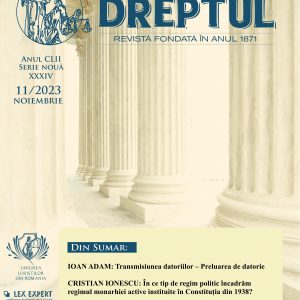
-
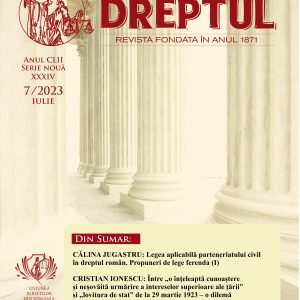
-
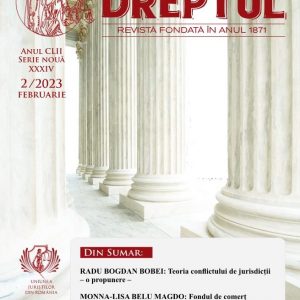
-
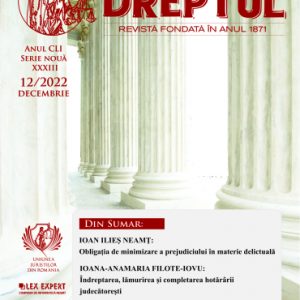
-
 After the entry into force of Article 1541 of the Civil Procedure Code, the judgments will have a different communication regime as compared to the other procedural documents. More precisely, if the party indicates the appropriate data in order to communicate the procedural documents by e-mail, the court will have the obligation to communicate the judgment to the party by e-mail, in accordance with the provisions of Article 1541 (1) of the Civil Procedure Code, however, it will not be obliged to communicate the summons or the other procedural documents to the respective party by e-mail, since with regard to these procedural documents remain applicable the provisions of Article 154 (6) of the Civil Procedure Code, which regulates only the possibility of the court to communicate these procedural documents by e-mail, and not the obligation of the court to proceed in this way. Therefore, we note the existence of an asymmetry, with regard to the communication regime, between the judgment and the other procedural documents, which is why we believe that the legislator should intervene in order to standardize the communication regime of all procedural documents, there being no reason why the respective communication of procedural documents should be carried out differently.
After the entry into force of Article 1541 of the Civil Procedure Code, the judgments will have a different communication regime as compared to the other procedural documents. More precisely, if the party indicates the appropriate data in order to communicate the procedural documents by e-mail, the court will have the obligation to communicate the judgment to the party by e-mail, in accordance with the provisions of Article 1541 (1) of the Civil Procedure Code, however, it will not be obliged to communicate the summons or the other procedural documents to the respective party by e-mail, since with regard to these procedural documents remain applicable the provisions of Article 154 (6) of the Civil Procedure Code, which regulates only the possibility of the court to communicate these procedural documents by e-mail, and not the obligation of the court to proceed in this way. Therefore, we note the existence of an asymmetry, with regard to the communication regime, between the judgment and the other procedural documents, which is why we believe that the legislator should intervene in order to standardize the communication regime of all procedural documents, there being no reason why the respective communication of procedural documents should be carried out differently. -
 We are researching the mechanism of proof necessary for the application of the sanction of the automatic exclusion of statements obtained through torture or other ill -treatment contrary to Article 3 of the Convention. The topic has not yet been addressed in Romanian law, although it is of indisputable importance for the practical application of the sanction. Proof to a high standard of ill-treatment is essential to the normative force of the sanction. The difficulty of proving ill-treatment is the main impediment to its application in judicial practice. The resulting problem is solved by the European Court of Human Rights through a mechanism of proof that manages the legal consequences of uncertainty and does not lose sight of the requirement to find out the truth. This mechanism has three main components: The first is the requirement of an arguable claim about the ill-treatment, which is similar to the formal burden of proof (the burden of adducing evidence) in common law, with the difference that it is not imposed on a particular party, but is met if information about ill-treatment comes to the attention of the authorities in any way. The second is the obligation to effectively investigate this claim. The third is the substantial burden of proof or persuasive burden, which must be met to a certain standard of proof. Ill treatment must be proven by the party alleging it to the standard of proof beyond a reasonable doubt, but this standard can be met by corroborated presumptions. We present some typical presumptions applicable in situations frequently encountered in practice. Under Article 6 of the European Convention on Human Rights, the requirements of the fair trial may justify derogations from these general principles. For the automatic exclusion of statements, two cumulative conditions must be verified: the lack of an effective investigation and the real risk of ill-treatment.
We are researching the mechanism of proof necessary for the application of the sanction of the automatic exclusion of statements obtained through torture or other ill -treatment contrary to Article 3 of the Convention. The topic has not yet been addressed in Romanian law, although it is of indisputable importance for the practical application of the sanction. Proof to a high standard of ill-treatment is essential to the normative force of the sanction. The difficulty of proving ill-treatment is the main impediment to its application in judicial practice. The resulting problem is solved by the European Court of Human Rights through a mechanism of proof that manages the legal consequences of uncertainty and does not lose sight of the requirement to find out the truth. This mechanism has three main components: The first is the requirement of an arguable claim about the ill-treatment, which is similar to the formal burden of proof (the burden of adducing evidence) in common law, with the difference that it is not imposed on a particular party, but is met if information about ill-treatment comes to the attention of the authorities in any way. The second is the obligation to effectively investigate this claim. The third is the substantial burden of proof or persuasive burden, which must be met to a certain standard of proof. Ill treatment must be proven by the party alleging it to the standard of proof beyond a reasonable doubt, but this standard can be met by corroborated presumptions. We present some typical presumptions applicable in situations frequently encountered in practice. Under Article 6 of the European Convention on Human Rights, the requirements of the fair trial may justify derogations from these general principles. For the automatic exclusion of statements, two cumulative conditions must be verified: the lack of an effective investigation and the real risk of ill-treatment. -
 In this study the author analyzes the victim’s obligation to minimize the damage in the context of a hypothesis of tort civil liability. In this sense, after a short introductory part intended to set the framework of the analysis, the author proposes to identify what would be the normative provisions from which the victim’s obligation to minimize the damage would derive, emphasizing the fact that, despite the lack of a clear and unequivocal rule in this sense, the existence of the obligation still derives from a whole series of legal provisions. The particularities of the obligation to minimize the damage are further addressed, its general legal regime being decrypted, with emphasis on those aspects that distinguish and individualize it in relation to other legal institutions, but also its mode of operation. Likewise, the author aims to identify the legal nature of the obligation to minimize the damage, underlining the limits of the theses advanced so far and showing why the obligation is a sui generis one. Further on, there are emphasized the consequences produced by the obligation to minimize the damage, whether respected by the victim or not, and in the end there are presented brief considerations referring to his procedural regime.
In this study the author analyzes the victim’s obligation to minimize the damage in the context of a hypothesis of tort civil liability. In this sense, after a short introductory part intended to set the framework of the analysis, the author proposes to identify what would be the normative provisions from which the victim’s obligation to minimize the damage would derive, emphasizing the fact that, despite the lack of a clear and unequivocal rule in this sense, the existence of the obligation still derives from a whole series of legal provisions. The particularities of the obligation to minimize the damage are further addressed, its general legal regime being decrypted, with emphasis on those aspects that distinguish and individualize it in relation to other legal institutions, but also its mode of operation. Likewise, the author aims to identify the legal nature of the obligation to minimize the damage, underlining the limits of the theses advanced so far and showing why the obligation is a sui generis one. Further on, there are emphasized the consequences produced by the obligation to minimize the damage, whether respected by the victim or not, and in the end there are presented brief considerations referring to his procedural regime.
